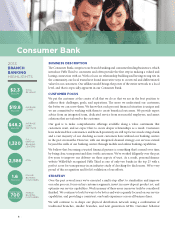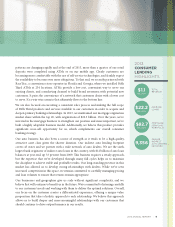Fifth Third Bank 2013 Annual Report Download - page 20
Download and view the complete annual report
Please find page 20 of the 2013 Fifth Third Bank annual report below. You can navigate through the pages in the report by either clicking on the pages listed below, or by using the keyword search tool below to find specific information within the annual report.
MANAGEMENT’S DISCUSSION AND ANALYSIS OF FINANCIAL CONDITION AND RESULTS OF OPERATIONS
18 Fifth Third Bancorp
The Bancorp was impacted by a number of components of the
Dodd-Frank Act which were implemented in 2012 and 2013. On
October 9, 2012, the FRB published final stress testing rules that
implement section 165(i)(1) and (i)(2) of the Dodd-Frank Act. The
BHC’s that participated in the 2009 SCAP and subsequent CCAR,
which includes the Bancorp, are subject to the final stress testing
rules. The rules require both supervisory and company-run stress
tests, which provide forward-looking information to supervisors to
help assess whether institutions have sufficient capital to absorb
losses and support operations during adverse economic conditions.
The FRB launched the 2013 capital planning and stress testing
program on November 9, 2012. The program includes the CCAR,
which included the 19 BHCs that participated in the 2009 SCAP, as
well as the CapPR which includes an additional 11 BHCs with $50
billion or more of total consolidated assets. The mandatory
elements of the capital plan were an assessment of the expected use
and sources of capital over the planning horizon, a description of all
planned capital actions over the planning horizon, a discussion of
any expected changes to the Bancorp’s business plan that are likely
to have a material impact on its capital adequacy or liquidity, a
detailed description of the Bancorp’s process for assessing capital
adequacy and the Bancorp’s capital policy. The stress testing results
and capital plan were submitted by the Bancorp to the FRB on
January 7, 2013. In March of 2013, the FRB disclosed its estimates
of participating institutions’ results under the FRB supervisory stress
scenario, including capital results, which assume all banks take
certain consistently applied future capital actions. In addition, the
FRB disclosed its estimates of participating institutions’ results
under the FRB supervisory severe stress scenarios including capital
results based on each company’s own base scenario capital actions.
The FRB’s review of the capital plan assessed the
comprehensiveness of the capital plan, the reasonableness of the
assumptions and the analysis underlying the capital plan.
Additionally, the FRB reviewed the robustness of the capital
adequacy process, the capital policy and the Bancorp’s ability to
maintain capital above the minimum regulatory capital ratios and
above a Tier I common ratio of five percent on a pro forma basis
under expected and stressful conditions throughout the planning
horizon. The FRB assessed the Bancorp’s strategies for addressing
proposed revisions to the regulatory capital framework agreed upon
by the BCBS and requirements arising from the Dodd-Frank Act.
In March 2013, the FRB announced it had completed the 2013
CCAR. For BHCs that proposed capital distributions in their plan,
the FRB either objected to the plan or provided a non-objection
whereby the FRB concurred with the proposed 2013 capital
distributions. The FRB indicated to the Bancorp that it did not
object to the following proposed capital actions for the period
beginning April 1, 2013 and ending March 31, 2014:
Increase in the quarterly common stock dividend to
$0.12 per share;
Repurchase of up to $750 million in TruPS subject to
the determination of a regulatory capital event and
replacement with the issuance of a similar amount of
Tier II-qualifying subordinated debt;
Conversion of the $398 million in outstanding Series
G 8.5% convertible preferred stock into
approximately 35.5 million common shares issued to
the holders. The Bancorp would intend to repurchase
common shares equivalent to those issued in the
conversion up to $550 million in market value, and
issue $550 million in preferred stock;
Repurchase of common shares in an amount up to
$984 million, including any shares issued in a Series G
preferred stock conversion;
Incremental repurchase of common shares in the
amount of any after-tax gains from the sale of Vantiv,
Inc. stock; and
Issuance of an additional $500 million in preferred
stock.
Beginning in 2013, the Bancorp and other large bank holding
companies were required to conduct a separate mid-year stress test
using financial data as of March 31st under three company-derived
macro-economic scenarios (base, adverse and severely adverse). The
Bancorp submitted the results of its mid-year stress test to the FRB
in July of 2013 and the Bancorp published a summary of the results
under the severely adverse scenario in September of 2013 which is
available on Fifth Third’s website at https://www.53.com. The FRB
launched the 2014 stress testing program and CCAR on November
1, 2013. The stress testing results and capital plan were submitted by
the Bancorp to the FRB on January 6, 2014. For further discussion
on the 2013 and 2014 Stress Tests and CCAR, see the Capital
Management section in MD&A.
Fifth Third offers qualified deposit customers a deposit
advance product if they choose to avail themselves of this service to
meet short term, small-dollar financial needs. In April of 2013, the
CFPB issued a “White Paper” which studied financial services
industry offerings and customer use of deposit advance products as
well as payday loans and is considering whether rules governing
these products are warranted. At the same time, the OCC and FDIC
each issued proposed supervisory guidance for public comment to
institutions they supervise which supplements existing OCC and
FDIC guidance, detailing the principles they expect financial
institutions to follow in connection with deposit advance products
and supervisory expectations for the use of deposit advance
products. The Federal Reserve also issued a statement in April to
state member banks like Fifth Third for whom the Federal Reserve
is the primary regulator. This statement encouraged state member
banks to respond to customers’ small-dollar credit needs in a
responsible manner; emphasized that they should take into
consideration the risks associated with deposit advance products,
including potential consumer harm and potential elevated
compliance risk; and reminded them that these product offerings
must comply with applicable laws and regulations. Fifth Third’s
deposit advance product is designed to fully comply with the
applicable federal and state laws and use of this product is subject to
strict eligibility requirements and advance restriction guidelines to
limit dependency on this product as a borrowing source. Fifth Third
believes this product provides customers with a relatively low-cost
alternative for such needs. On January 17, 2014, given
developments in industry practice, Fifth Third announced that it will
no longer enroll new customers in its deposit advance product and
will phase out the service to existing customers by the end of 2014.
These advance balances are included in other consumer loans and
leases in the Bancorp’s Consolidated Balance Sheets and represent
substantially all of the revenue reported in interest and fees on other
consumer loans and leases in the Bancorp’s Consolidated
Statements of Income and in Table 5 in the Statements of Income
Analysis section of the MD&A. Fifth Third has been monitoring
industry developments and is working to develop and implement
alternative products and services in order to address the needs of its
customers. The Bancorp is currently in the process of evaluating the
impact to the Bancorp’s Consolidated Financial Statements of both
the phase out of our deposit advance product and our development
of alternative products and services.
In December of 2010 and revised in June of 2011, the BCBS
issued Basel III, a global regulatory framework, to enhance
international capital standards. In June of 2012, U.S. banking
regulators proposed enhancements to the regulatory capital
requirements for U.S. banks, which implement aspects of Basel III,
























